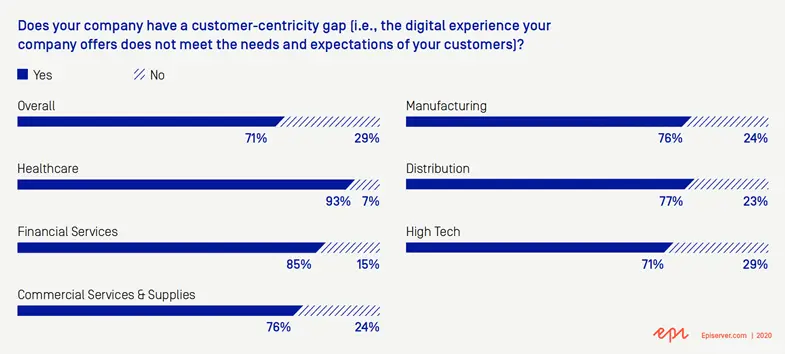The B2B customer-centricity gap culprit: Amazon
This may sound like a broken record but: customer expectations for seamless digital experiences are at an all-time high. These high expectations aren't exclusive to the B2C world. B2B buyers have the same standards throughout their journey to purchase as they do in their personal shopping lives.

Morgan Short

Episerver recently surveyed 600 leaders in marketing, IT and ecommerce roles at B2B companies to learn how they rank their digital experiences. Some of the most striking results from Episerver’s B2B Digital Experience Report are centered around the customer-centricity gap that seems to exist across industries.
Before digging into the data, here’s what constitutes a customer-centricity gap:
In short, having a customer-centricity gap means the digital experience your company offers does not meet the needs and expectations of your customers.
Admitting you have a gap in serving your customers is probably the last thing you want to do. You prioritize your customers. You do everything in your power to say ”yes” to them. Despite it being hard to admit, B2B companies unanimously agree that their company has a customer-centricity gap.
71 percent of companies we surveyed said their company’s digital experience does not meet the needs and expectations of their customers. The news is even worse for manufacturers and distributors who came in at 76 and 77 percent prospectively.

These aren’t exactly fun statistics. Albeit, they give companies something to work toward.
So, a customer-centricity gap exists and it seemingly persists across every industry at high rates. But I wanted to know why we are seeing such high reports of gaps in manufacturing and distribution.
That’s why in a recent roundtable about digital practices and what’s next in B2B, we asked manufacturers and distributors about the customer-centricity gap.
The culprit? Amazon of course.
One of the roundtable participants, a marketing leader from a distributor of electrical products, explained that Amazon is the reason why their customers’ expectations are so high. Midsized manufacturers and distributors don’t have the money to compete with the Amazon’s of the world. They must balance time, resources and people to best serve their customers. In short, they’ll never be able to out-Amazon, Amazon.
Another participant, an ecommerce strategist from an industrial distribution company, agreed. Their company has to meet customers’ expectations that are being molded by Amazon. Their biggest challenge is taking their current offline experience and their account managers out in the field, and getting that experience translated online. He described it as, ”A tall mountain to climb.”
It seems manufacturers and distributors have a common enemy. But not all is lost to Amazon. With the right strategy, manufacturers and distributors can come out on top. Here are five tips for outperforming Amazon and closing the customer-centricity gap in manufacturing and distribution:
- Prioritize omnichannel experiences.
It’s not all digital. It’s not all traditional. Some customers, especially those in younger generations, prefer to self-serve online whenever possible. While other folks may prefer to pick up the phone or stop in for some face-to-face action (social distancing and masks included). You don’t have to be Amazon to deliver powerful customer experiences. You just have to meet your customers where they’re at. But, I will say, if your site is looking like something out of the 90s, you may want to consider giving your digital experience an overhaul.
- Differentiate with value-added services.
Amazon Business isn’t the only marketplace you have to keep in mind. As more B2B marketplaces pop up, manufacturers and distributors can differentiate themselves with value-added services. If it’s human, chances are Amazon isn’t offering it. If you don’t have a library of services, start there. Do you have experts that can help repair or inspect parts? Can you offer trainings? What about preassembly of your products? Where can you add more value to your customers? This is profit waiting to be collected. Plus, it’s a great way to stick it to Amazon who absolutely can’t compete with your expertise.
- Listen to your customer.
I’m not necessarily referring to data here. We all know how much data Amazon has, and that they likely have an entire team of analysts constantly monitoring that data. Data is great, but it’s only one piece of the puzzle. Conduct quarterly voice of the customer surveys. Start a customer advisory board. Heck, take one of your customers out to a free lunch and let him or her gripe a bit about the things you could do better. If one customer feels a certain way - it's likely there are others with the same frustrations and praises. Take that information, however it's collected, and make sure your customer feels its impact in a tangible way. Remember, don't just listen to respond. Instead, listen to understand, then respond in a way that brings your customers value. Sure, Amazon might have you beat on data sophistication, but you’re closer to your customers than Amazon is.
- Hire someone solely dedicated to fielding customer input that improves your digital experience.
I love this one because I’ve seen it work first-hand. We recently interviewed Josh Schoonmaker, Director of Digital Solutions at Consolidated Supply about the success he’s seen since partnering with Episerver. Implementing an ecommerce website was one thing, but the real success came when Josh dedicated a team of Digital Engagement Specialists (DES) to make the technology even stronger. The DES at Consolidated Supply is responsible for fielding customer feedback about the website and making continuous improvements to meet those expectations.
- If you can’t beat 'em, join 'em.
We’ve seen some manufacturers and distributors see success by selling on B2B marketplaces. You may consider taking this route to move your low-margin inventory. Most higher profit, complex buys require human intervention or ecommerce software that’s built for that kind of complexity. But you can try your hand at putting lower margin products on marketplaces. Or maybe you have a parts play. Either way, there’s hidden advantages to selling in a B2B marketplace that might just be worth trying out.
Customer-centricity may be a bit of a clichéd term, but people hop on the bandwagon for a reason. You want to do right by your customers. You want to close the gap that exists between what you’re delivering and what your customers expect. Hopefully, these tips for outperforming the player that’s setting the gold standard for customer experience will help.
